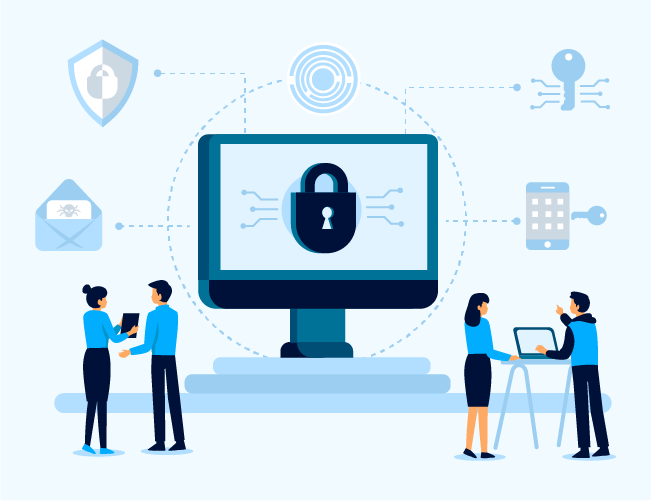Since the COVID-19 pandemic took off, companies have been frantically adjusting work operations to accommodate employee safety while keeping their business sustainable. For many industries, particularly white-collar jobs, this has resulted in employees working remotely. Now, many regions of the country are in the middle of gradual reopenings, yet some safeguards used in return-to-work plans are proving to be not as effective.
Employers that are relying on employee screening protocols, like temperature checks and questionnaires, may want to reconsider that strategy. Recent research from South Korea suggests that asymptomatic carriers of the virus could be contagious for up to 30 days after a confirmed diagnosis. In a study of over 300 COVID-19 patients, including many that didn’t show any symptoms, these asymptomatic patients’ viral loads also declined more slowly than those exhibiting symptoms. The findings suggest that isolating asymptomatic carriers may be the key to controlling community spread. However, many businesses are only screening employees and customers for symptoms and not performing any testing.
Unfortunately, conducting routine tests—either on-site or through a third party—on employees isn’t a feasible return-to-work strategy either. Issues surrounding the costs, accuracy, privacy, waiting times for results, and access have led to the overwhelming opinion that the tests are just more trouble than they’re worth. The tests only measure a person’s health in that moment; even frequent tests potentially miss out on the time it takes for a carrier of the virus to infect other individuals at the workplace before getting a positive test result. The resources that would need to be spent on daily testing is also not sustainable for most businesses.
The shortcomings of tests and screenings have now put employers in a difficult situation. Without an effective way to monitor their employees’ exposure to COVID-19, businesses risk having to repeatedly deal with workers out-of-work due to quarantines or more closures due to a spread as well as potential liability from lawsuits. This back-and-forth substantially hurts productivity and profits. Therefore, it may be simpler and more effective for employees to remain working remotely for the foreseeable future.
Commit To Remote Work For The Long-term
Businesses that can continue to operate with employees off-site may want to change their mindset about remote work. What started as a temporary solution for many workers may now be best viewed as a long-term plan. This commitment will relieve the many stresses, administrative burdens, and extra costs associated with constantly planning around weekly changes in local policy and community health. It also provides more consistency and stability for employees.
It will be important to prepare for maintaining this commitment even if a vaccine is announced. While many are hopeful that immunization could speed up a return to normal, the reality is that a COVID-19 vaccine is not favorably viewed by many people. Currently, only about half of American adults would choose to receive the vaccination. Those who would decline cite safety concerns, while others simply do not fear getting infected in the first place. With this in mind, employers may want to temper their optimism and proceed with caution when any new solutions for controlling COVID-19 are announced.
Reshape Benefits Accordingly
Employers should also review company policies, employee benefits, and wellness programs to align with this new way of working and interacting. While some employers may have taken certain short-term measures, such as adding more scheduling flexibility, more needs to be done to fully support workers in this environment.
- Make Wellness Virtual – Gym memberships, in-person healthcare resources, and social events need to be exchanged for increased virtual options. Mental and emotional stresses are high, so increasing access to online content, telemedicine, and wellness resources is key. While more people will be working independently, keep communication open by allowing for casual conversation before or after virtual meetings.
- Help Families – Many working parents are dealing with increased childcare demands as well as facilitating learning at home. Even if schools reopen for in-person instruction, there may be other closures throughout the coming academic year. Anticipating this, parents are keeping plans in place to handle at-home instruction; some are committing to homeschooling for the entire year. Instead of risking high employee turnover due to parents quitting, employers can support their employee-caregivers’ needs through flexible scheduling or increasing their amount of available time off. Provide access to content and resources for teaching at home, or even consider offering stipends to educational app subscriptions or online learning material. Cater any mental health resources or counseling services towards those taking care of children or family members.
- Support Balance – For employees struggling to create a productive work environment remotely, companies should provide assistance by directing money saved from reduced on-site office perks to stipends for home supplies and equipment. Likewise, it is just as (or more) important to establish healthy boundaries between work and personal time. Honor employees’ personal lives by not communicating after hours or during time off. This also means that managers need to encourage and enable their workers to continue to take time off to avoid overworking, mental exhaustion, and stress. With traditional vacations currently out of the question, employers should over-communicate the importance in dedicating time away from work. Suggest that days off be used for personal hobbies, family events, mental health days, or short-term breaks.












